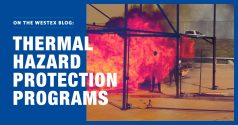
Are you a March Madness fan? Chances are, you’ve never contemplated the similarities between zone defense of your favorite basketball team and the “defense” that flame-resistant (FR)/arc-rated (AR) PPE plays in mitigating thermal hazard risks in workplace settings. In either case, solid zone defense and FR/AR PPE do more than just one job.
Much like a team of five defending the basket with the classic 2/3 zone defense, FR/AR garments play two distinct roles across three hazard “zones.”
FR/AR garments, as part of a comprehensive protection program against thermal hazards, serve a dual-purpose of limiting the thermal exposure time and providing insulation to mitigate burn injuries. No matter the type of thermal hazard, these garments must offer self-extinguishing and insulating properties according to appropriate industry safety standards. These two areas work together to help reduce both burn extent (the overall body burn percentage) and severity (resulting second- and third-degree burns), thereby increasing the chance of survival should an incident occur.
Let’s explore the two roles FR/AR garments play:
- Self-Extinguish: Arguably its most important job, FR/AR clothing self-extinguish upon removing an ignition source thanks to the FR/AR fabric. A hallmark of short-term thermal hazards, the ignition source is often a powerful yet fleeting force; however, once something is ignited, it can continue to burn long after the event is over. If you aren’t wearing FR/AR garments, then your clothes can act as fuel and continue to burn. The self-extinguishing property, often known as flame resistance, is the most critical component of FR/AR garments—no matter the thermal hazard you might face—because it makes the difference between whether your clothes burn or not.
-
- When utilizing proven, branded FR/AR fabric in your protective garments, this key characteristic is woven directly into the garment and remains for the life of the garment. So long as the FR/AR garment is maintained according to the manufacturer’s care instruction, the garment will remain flame resistant.
- Insulate: Providing insulation against thermal energy exposure is the secondary job of FR/AR garments. Compliant fabrics will insulate and help reduce the severity of skin burns during an incident, leading to a lower percentage of second- and third-degree burns. Depending on the hazard you face, there are different industry standards to which your FR/AR garments, and the fabric it comprises, must comply. Standards to reference are NFPA 70E® and ASTM F1506 for arc flash, NFPA® 2112 and 2113 for flash fire, or ASTM F1002 for secondary PPE’s molten metal splash protection. Keep in mind that these consensus standards provide minimum fabric performance requirements. Research full test results and analyze the performance of the garment’s fabric in the field to arrive at the best fabric selection for your garments.
-
- For arc flash hazards, insulation is assessed through arc ratings. A garment’s arc rating signals the fabric’s performance when protecting against second-degree burns during an arc flash incident. This rating is measured in cal/cm2 and gives the incident energy at which there is a 50% probability of a second-degree burn onset. This arc rating will determine a garment’s PPE category according to NFPA 70E. Using the NFPA 70E tables to match the electrical task to the appropriate PPE category and knowing the PPE’s arc rating will help properly insulate the wearer. It is best practice to select FR/AR clothing that meets the PPE category required for your specific task, or that has an arc rating greater than or equal to your job’s anticipated incident energy.
- For flash fire hazards, insulation is assessed through body burn percentages at the three-second exposure test (conducted via ASTM F1930: Thermal Manikin Test). The fabric must achieve 50% or less body burns (second- or third-degree) to comply with NFPA 2112.
- For molten metal splash or welding slag, insulation is assessed by the fabric’s ability to shed molten metal from its surface without sticking. A qualified safety professional conducting an on-site splash test helps determine the fabric’s ability to shed a certain amount of a specific alloy of molten metal and specifies what type of PPE, garments included, are required for a particular task.
The self-extinguishing and insulating properties of FR/AR fabrics are vital in providing workers a final layer of defense across these three thermal hazards. Whether you’re dealing with a hazard mitigation program or settling in for a March Madness game, the old-school 2/3 zone defense philosophy can always be helpful.
